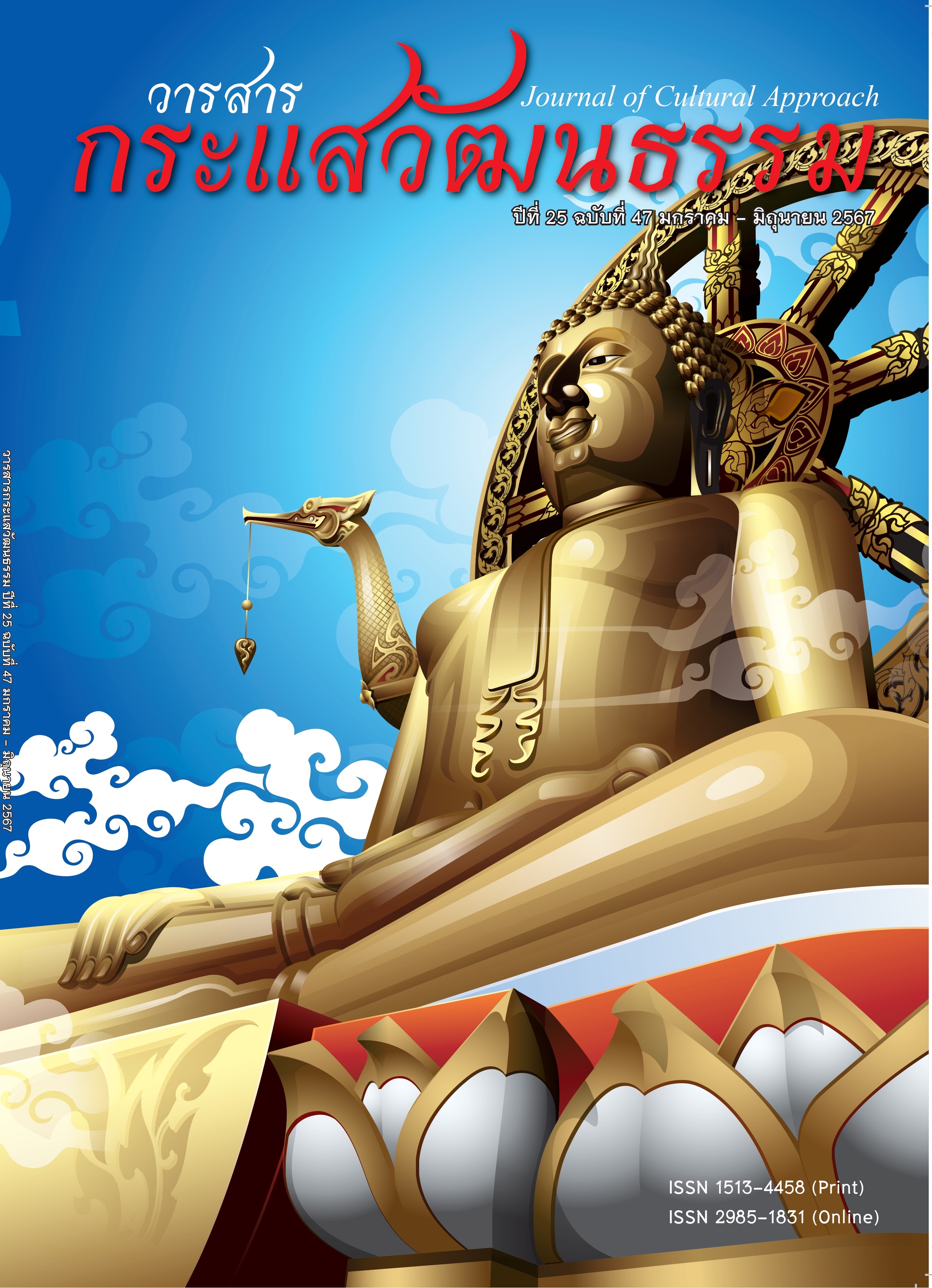The Foreign Tourists’ Attitude toward Cultural Tourism through the Ancient Monuments in Bangkok
Main Article Content
Abstract
Cultural tourism has an important role in Thai tourism. The perspectives of foreign tourists from all regions of the world, form their attitudes toward Thailand and influences what they buy from the travel agents. The tours bought are for all groups of tourists from different economic statuses. All tour groups see the importance of ancient monuments, which explain Thai civilization, especially, the Temple of the Emerald Buddha, Wat Arun Ratchawararam, Wat Bowonniwet Vihara, and Wat Suthat Thepwararam, which are respectable temples from the Rattanakosin period. The study aims to learn foreign tourist attitudes and opinions, about ancient monuments in Bangkok to help develop, preserve, and protect cultural tourist attractions. Furthermore, it will determine the direction of tourism and policies to attract foreign tourists in order to create commercial value and import foreign currency.
The study uses a descriptive statistics questionnaire related to attitude levels, including Likert scale, hypothesis testing (t-stat), and the relation between gender, age, educational level and opinion about Thai tourism, including open–ended questions asking opinions.
The study shows that Thailand has cultural tourist attraction stemming from a long history. Tourist like to pay respect to Buddha images and visit ancient monuments because they have an elegance and reflect Thailand’s ancient civilization. Tourists are impressed with Thai food, and activities related to Thai culture. These are ways to determine policies and measures to promote Thai tourism to foreign tourists and attract foreign currency to Thailand.
Article Details

This work is licensed under a Creative Commons Attribution-NonCommercial-NoDerivatives 4.0 International License.
Proposed Creative Commons Copyright Notices
1. Proposed Policy for Journals That Offer Open Access
Authors who publish with this journal agree to the following terms:
- Authors retain copyright and grant the journal right of first publication with the work simultaneously licensed under a Creative Commons Attribution License that allows others to share the work with an acknowledgement of the work's authorship and initial publication in this journal.
- Authors are able to enter into separate, additional contractual arrangements for the non-exclusive distribution of the journal's published version of the work (e.g., post it to an institutional repository or publish it in a book), with an acknowledgement of its initial publication in this journal.
- Authors are permitted and encouraged to post their work online (e.g., in institutional repositories or on their website) prior to and during the submission process, as it can lead to productive exchanges, as well as earlier and greater citation of published work (See The Effect of Open Access).
Proposed Policy for Journals That Offer Delayed Open Access
Authors who publish with this journal agree to the following terms:
- Authors retain copyright and grant the journal right of first publication, with the work [SPECIFY PERIOD OF TIME] after publication simultaneously licensed under a Creative Commons Attribution License that allows others to share the work with an acknowledgement of the work's authorship and initial publication in this journal.
- Authors are able to enter into separate, additional contractual arrangements for the non-exclusive distribution of the journal's published version of the work (e.g., post it to an institutional repository or publish it in a book), with an acknowledgement of its initial publication in this journal.
- Authors are permitted and encouraged to post their work online (e.g., in institutional repositories or on their website) prior to and during the submission process, as it can lead to productive exchanges, as well as earlier and greater citation of published work (See The Effect of Open Access).
References
Janprakhon, S. (2010). Factor Influencing on Decision Making to Selection Khmer Art and Cultural Touring: A Case Study of Ancient Places in Nakorn Ratchasima and Buri Ram Province. Khon Kaen University.
Jarumanee, N. (2001). Tourism and Management of Tourist Industry in Bangkok. O.S. Printing.
Krungthai Compass. (2024). Thai Tourism in 2024 Expects Income of 2.52 Trillion to Support Spending almost 10 Times more than Thai People. https://www.thairath.co.th/money/economics/thailand_econ/2764434
Pamaranont, P. (2019). The Factors Affecting to the Decision-Making of Thai Tourists on Travailing to Historical and Cultural Tourist Attractions in Pranakorn Si Ayutthaya Province. Bangkok University.
Pongtratik, C., Nimnatipan, S. & Malarak, A. (2021). The Development of Cultural Tourism Strategies in Prachuap Khiri Khan Province. Srinakharinwirot University.
Ruchdaponkul, S. (2021). Economic Management of Archaeological Site Tourism in Thailand. The National Defence College of Thailand Journal, 63(1), 57-69.
Smith, V. L. (1996). Indigenous Tourism: the Four Hs. In Butler, R. W. & Hinch, T. D. (eds.), Tourism and Indigenous Peoples. International Thomson Business Press.
Thaipost. (2023). E-Publication News. https://www.thaipost.net/e-pub-news
Wallerstein, I. (1974). The Modern World System I. New York Academic.
Wallerstein, I. (1979). The Capitalist World – Economy. Cambridge University Press.
Wallerstein, I. (1991). Culture as the Ideological Battleground of the Modern World – System in Geopolitics – Geoculture. Cambridge University Press.
Wantanom, C. (2001). Factors of Tourists’ Decision-Making Effect on Select Domestic Travelling in Thailand. Chiang Mai University.


